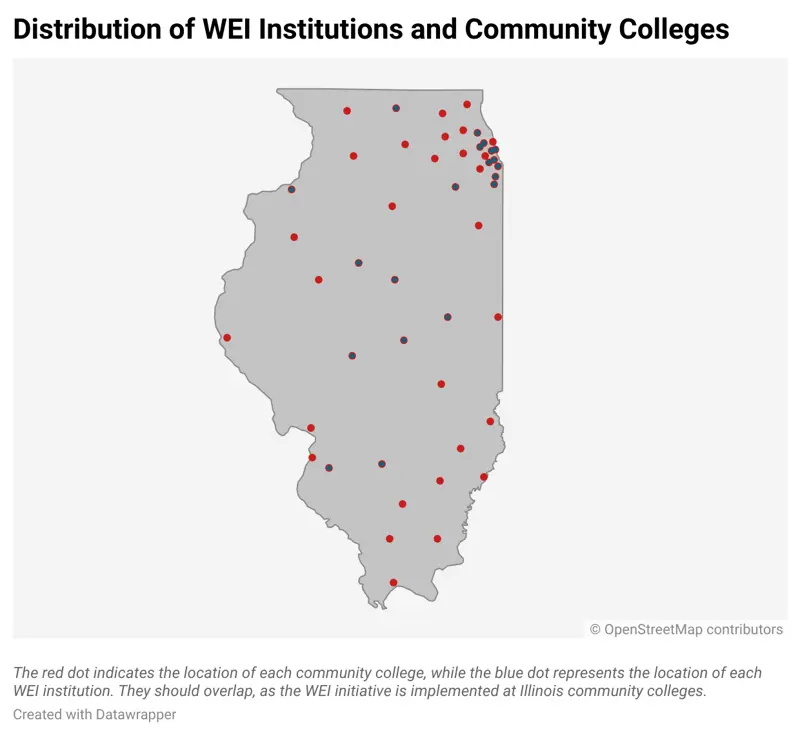Education Deserts and Workforce Development for Adult Learners in Illinois
By Jeongsan Hwang

Introduction
Workforce development—the education and training of individuals to meet labor market demands—is a foundation of economic growth and social mobility. As the economy advances beyond a knowledge-based society and the job market grows increasingly competitive, workforce development has gained greater significance in society.
Despite the significance of workforce development, some populations are unable to access these opportunities, particularly those residing in education deserts. The concept of an "education desert"—an area with limited or no nearby broad-access public colleges—highlights the role of geography in educational opportunity (Hillman, 2016, 2019). Education deserts strongly correlate with stagnant social mobility, particularly affecting under-resourced rural communities (Chetty et al., 2014). Although community colleges have served as primary institutions of workforce education for over a century (O'Banion, 2019), offering geographically accessible and financially affordable education compared to other institutions, community college deserts also exist.
This policy brief examines the presence of community college deserts among institutions affiliated with the Workforce Empowerment Initiative (WEI) in Illinois. As discussed in subsequent sections, many regions in Illinois, particularly those outside the Chicago metropolitan area, lack access to training institutions. Addressing these geographic inequalities is critical to ensuring all Illinois residents can obtain the workforce credentials necessary for economic stability and employability. Based on this observation, the policy brief concludes by providing policy recommendations to mitigate this geographical inequity.
Workforce Empowerment Initiative (WEI) in Illinois
Illinois has begun to recognize the need to address educational deserts and workforce gaps through targeted programs. One notable effort is the recently recalibrated WEI, launched in 2019 by the Illinois Community College Board with local community colleges and the Illinois Legislative Black Caucus. WEI is designed to "expand skills-gap training for minority students in distressed communities," providing short-term workforce programs that lead to high-demand, high-wage employment opportunities (Workforce Equity Initiative [WEI], 2025).
By the fiscal year 2024, nearly 16,000 students from diverse populations had participated in WEI-funded training programs, including a critical mass of African American adult learners (WEI, 2025). Among program completers, approximately 69% secured employment immediately upon finishing their training, with salaries meeting or exceeding the target wage level (WEI, 2025). In other words, WEI effectively provided substantial support to adult learners, helping them achieve economic stability and secure employment.
However, the need for workforce development opportunities exceeds the current supply. WEI serves only 2.9% of the community college population, which includes over 552,000 Illinois students enrolled in fiscal year 2024 (ICCB, 2024). Although 20 community colleges are currently joining this initiative across Illinois (WEI, 2025), the geographical distribution of WEI institutions remains limited, as illustrated in Figure 1. This figure indicates that the current distribution of WEI institutions is predominant in the Chicago metropolitan area or certain parts of Central Illinois, leaving many Illinois residents outside these service areas, particularly diverse communities in the southern and western parts of the state.
Figure 1. Distribution of WEI Institutions and Community Colleges across Illinois

To make a substantial impact statewide, and effectively meet the demand of Illinois residents for workforce development opportunities, the state must supplement WEI with additional strategies that address geographical barriers to educational access.
Education Deserts and their Effects
Geography significantly influences individuals' opportunities to access a college education. Two-thirds of U.S. undergraduates attend colleges located within 25 miles of their homes, underscoring that the distance to colleges is a key factor in their college choice (Hillman, 2016). In contrast, individuals residing in education deserts may likely face significant barriers to pursuing higher education, regardless of personal motivation or academic preparation (Hillman, 2016). Students raised in education deserts face limited college choices and often either incur high living costs to attend distant institutions or forgo college altogether, resulting in lower enrollment and completion rates.
Furthermore, education deserts disproportionately affect marginalized populations. Education deserts are typically concentrated in high-poverty, racially minoritized communities, whereas more affluent, predominantly white neighborhoods enjoy greater proximity to multiple college options (Hillman, 2016). For example, Acton et al. (2024) found that in Texas, Black, Hispanic, and low-income students in education deserts were significantly more likely to forgo higher education, whereas white, Asian, and wealthier peers in similar areas often attended four-year institutions and completed degrees at higher rates. In other words, the intersections of geographic isolation and students' socioeconomic and racial backgrounds can further compound structural barriers to accessing higher education.
The adverse effects of education deserts become more severe for adult learners. Adult learners typically balance educational pursuits with employment and family responsibilities (MacDonald, 2018), facing challenges in accessing workforce education opportunities, especially if they reside in areas with limited educational resources, despite their motivation. The evolving nature of work in the post-pandemic era has further heightened the challenges faced by adult learners in accessing these opportunities, as it requires them to develop new work competencies (Wildavsky, 2021).
Given that regions lacking educational infrastructure exhibit lower rates of upward mobility (Chetty et al., 2014), the interplay between educational deserts and the challenges faced by adult learners from marginalized backgrounds may contribute to sustained poverty in subsequent generations. The negative impacts of education deserts, addressed in this section, highlight the importance of implementing effective policy interventions to address this issue.
Policy Recommendations
To mitigate the adverse effects of education deserts on workforce development in Illinois, this brief suggests the following policy recommendations.
Expand Online Education
Providing WEI programs through expanding online modality can help overcome the barrier of distance. By enabling adult learners to earn certificates or degrees remotely, Illinois can reduce reliance on physical proximity to educational campuses and effectively serve students in all regions of the state.
The rapid expansion of online education during the COVID-19 pandemic demonstrated that WEI institutions can effectively teach essential workforce-related skills through an online education model (Jacobs et al., 2023). Providing online and hybrid education programs will significantly enhance educational accessibility in education deserts. However, institutions need to provide adequate technical support and accommodations together to support adult learners who may have limited experience in virtual environments.
Additionally, as residents living in education deserts often face high poverty rates and limited internet access, this may constrain the effectiveness of online education (Stowe & Warren, 2021). Therefore, institutions should pair efforts to expand online and hybrid learning modalities with parallel strategies that actively promote improved internet and technological accessibility, addressing infrastructure gaps that could otherwise undermine equitable participation (Hillman, 2019).
Cultivate Local Support Services and Satellite Facilities
Adult learners in education deserts often lack access to advising, mentoring and other supports traditionally available to on-campus students. To address this gap, Illinois can invest in establishing community-based education centers or partnerships within underserved areas (McBride, 2025). For example, public libraries, K-12 school buildings or community organization facilities could serve as satellite sites where students access tutoring, academic advising, career counseling and computer labs.
Building stronger local support networks will improve persistence and success for adult learners who cannot regularly travel to main campuses (Watt & Gardiner, 2016). These satellite centers should serve the needs of adult learners by providing flexible hours and staff that can assist nontraditional students. By replicating critical elements of the campus experience within local communities, Illinois can help adults in education deserts successfully navigate their educational journeys.
Strengthen Industry and Community College Partnerships
Leveraging the local industry can facilitate the delivery of training programs directly to communities most in need through partnerships with various stakeholders. For example, effective rural science, technology, engineering, mathematics, and medicine (STEMM) education relies on robust partnerships between community colleges and local industry, providing hands-on, practical training aligned with regional workforce demands (McBride, 2025). Through this partnership, adult learners can access workforce development opportunities within their communities, while employers can satisfy their workforce needs without incurring additional hiring costs.
Illinois has already proactively addressed educational needs in rural communities. For example, a local network in the Quad Cities region was established to align educational pathways with employment opportunities through cohesive partnerships among K-12 educators, higher education institutions and regional employers (WestEd, 2024). These partnerships provide residents in the Quad Cities with several work-based learning options, enabling them to earn income and develop essential skill sets (WestEd, 2024). Although this initiative currently targets specific areas rather than addressing all education deserts across the state, it illustrates the potential for expanded local partnerships between WEI institutions and regional employers.
Conclusion
Geographic disparities in educational access may pose a significant threat to Illinois' workforce development and economic inclusion goals. While Illinois' WEI initiatives have yielded promising outcomes, institutions and various stakeholders, including local employers and the state, should scale up their efforts and strategically collaborate to serve more adult learners who reside in underserved areas, considering that education deserts may exacerbate existing inequities. The current policy brief suggests three policy recommendations: (1) providing online education, (2) strengthening community-based support networks and (3) fostering strong local partnerships with regional employers. WEI initiatives can address overall community needs by expanding access to WEI opportunities in underserved areas, potentially leading to a more skilled workforce, thriving local economies, and an improved quality of life for adult learners and their communities.
References
Acton, R., Cortes, K. E., Miller, L., Morales, C., Baker, R., Bleemer, Z., Bonilla, S., Carruthers, C., Imberman, S., Lovenheim, M., & Taylor, L. (2024). Distance to degrees: How college proximity shapes students’ enrollment choices and attainment across race-ethnicity and socioeconomic status (EdWorkingPaper No. 24-1055). Annenberg Institute, Brown University. https://doi.org/10.26300/vjyg-ta27
Chetty, R., Hendren, N., Kline, P., & Saez, E. (2014). Where is the land of opportunity? The geography of intergenerational mobility in the United States. Quarterly Journal of Economics, 129(4), 1553–1623. https://doi.org/10.1093/qje/qju022
Hillman, N. W. (2016). Geography of college opportunity: The case of education deserts. American Educational Research Journal, 53(4), 987–1021. https://doi.org/10.3102/0002831216653204
Hillman, N. W. (2019). Place matters: A closer look at education deserts. Third Way. https://www.thirdway.org/report/place-matters-a-closer-look-at-education-deserts
Illinois Community College Board. (2024, December 24). Student Enrollments and Completions in the Illinois Community College System: Fiscal Year 2024. https://www.iccb.org/wpcontent/uploads/2024/12/Annual_Enroll_Comp_2024_Final.pdf
Jacobs, B., Taljaard-Swart, H., Marx-Pienaar, N., Diedericks, L., Sonnenberg, N., Donoghue, S., ... & du Rand, G. (2023). Preparing students for the future workplace: how online teaching and learning during the COVID-19 pandemic hone required transferable skills. Education+ Training, 65(10), 81-97.
MacDonald, K. (2018). A review of the literature: The needs of nontraditional students in postsecondary education. Strategic Enrollment Management Quarterly, 5(4), 159-164.
McBride, R. (2025). Traversing educational deserts: A community case study of technical STEMM pathways in Wyoming's rural remote transfer ecosystem. Front. Educ., 10.
https://doi.org/10.3389/feduc.2025.1560279
O’Banion, T. U. (2019). A Brief History of Workforce Education in Community Colleges. Community College Journal of Research and Practice, 43(3), 216–223. https://doi.org/10.1080/10668926.2018.1547668;WEBSITE:WEBSITE:TFOPB;PAGEGROUP:STRING:PUBLICATION
Stowe, K., & Warren, M. (2021). Education deserts in North Carolina: An analysis of geographic disparities and university access. Research in Higher Education Journal, 40. http://www.aabri.com/copyright.html
U.S. Bureau of Labor Statistics. (2024). Employment Projections: Education Pays. http://bls.gov/emp/chart-unemployment-earnings-education.htm
Vaughan, T. (2024, May 15). Equitable career pathways and workforce development initiatives: Are we truly serving learners from low-income backgrounds? Pell Institute. https://pellinstitute.org/equitable-career-pathways-and-workforce-development-initiatives-are-we-truly-serving-learners-from-low-income-backgrounds/
Watt, H., & Gardiner, R. (2016). Satellite Programmes: Barriers and Enablers for Student Success. Ako Aotearoa.
WestEd. (2024). Thrive quad cities: An education and workforce analysis final report. https://www.ibhe.org/assets/files/Reports/Final_IBHE_WestEd_Thrive_Quad_Cities_Report.pdf
Wildavsky, B. (2021). Meeting the needs of working adult learners: Students and administrators on post-pandemic imperatives. The Chronicle of Higher Education. https://connect.chronicle.com/rs/931-EKA-218/images/ServingPostTraditionalStudents_GuildEducation.pdf
Workforce Equity Initiative [WEI]. (2025). Five-Year Outcome Report. https://drive.google.com/file/d/1ebNq4mcNAoZ4yuNVBeDvXAWnZmge0puV/view